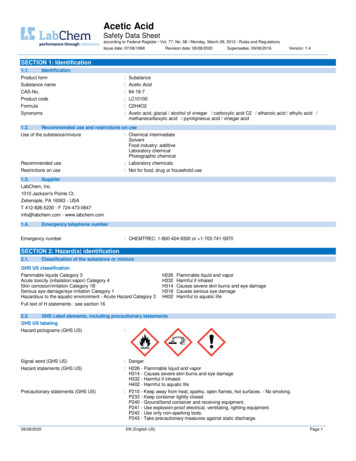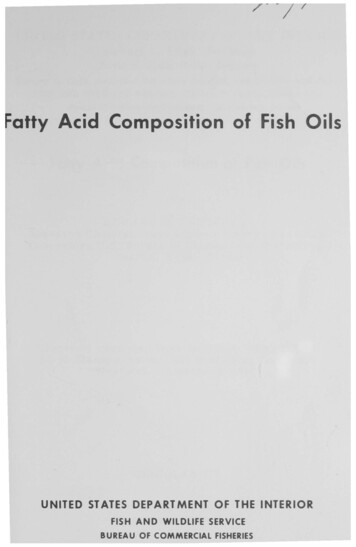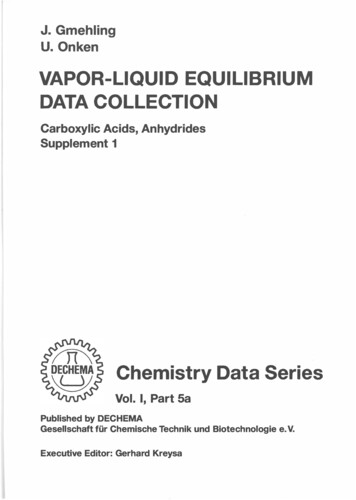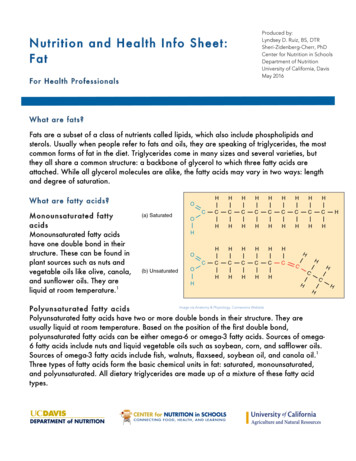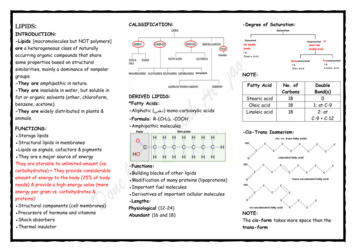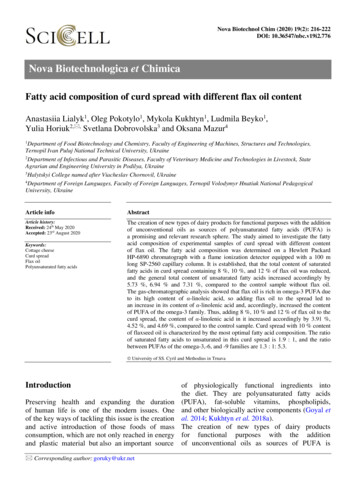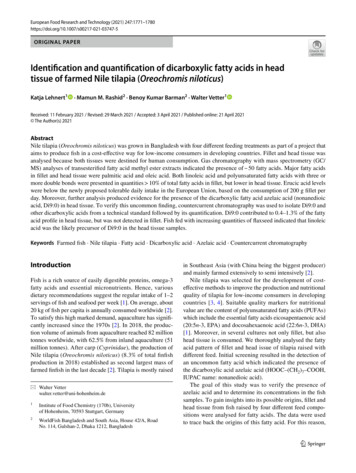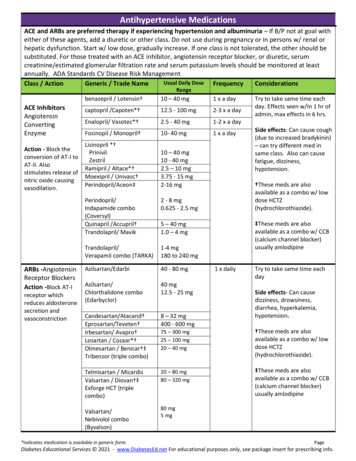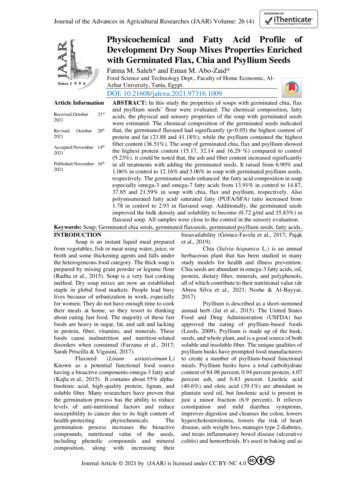
Transcription
Journal of the Advances in Agricultural Researches (JAAR) Volume: 26 (4)Physicochemical and Fatty Acid Profile ofDevelopment Dry Soup Mixes Properties Enrichedwith Germinated Flax, Chia and Psyllium SeedsFatma M. Saleh* and Eman M. Abo-Zaid*Food Science and Technology Dept., Faculty of Home Economic, AlAzhar University, Tanta, Egypt.DOI: 10.21608/jalexu.2021.97316.1009Article InformationABSTRACT: In this study the properties of soups with germinated chia, flaxand psyllium seeds’ flour were evaluated. The chemical composition, fattyReceived:October21stacids, the physical and sensory properties of the soup with germinated seeds2021were estimated. The chemical composition of the germinated seeds indicatedthat, the germinated flaxseed had significantly (p 0.05) the highest content ofRevised: October 20th2021protein and fat (23.88 and 41.18%), while the psyllium contained the highestfiber content (36.51%). The soup of germinated chia, flax and psyllium showedthAccepted:November 14the highest protein content (15.17, 32.14 and 16.29 %) compared to control2021(9.23%). it could be noted that, the ash and fiber content increased significantlyPublished:November 16thin all treatments with adding the germinated seeds. It raised from 6.90% and20211.06% in control to 12.16% and 5.06% in soup with germinated psyllium seeds,respectively. The germinated seeds enhanced the fatty acid composition in soupespecially omega-3 and omega-7 fatty acids from 13.91% in control to 14.87,37.85 and 21.59% in soup with chia, flax and psyllium, respectively. Alsopolyunsaturated fatty acid/ saturated fatty (PUFA/SFA) ratio increased from1.78 in control to 2.93 in flaxseed soup. Additionally, the germinated seedsimproved the bulk density and solubility to become (0.72 g/ml and 35.83%) inflaxseed soup. All samples were close to the control in the sensory evaluation .Keywords: Soup; Germinated chia seeds, germinated flaxseeds, germinated psyllium seeds, fatty acids.INTRODUCTIONbioavailability (Gómez-Favela et al., 2017; PająkSoup is an instant liquid meal prepared et al., 2019).from vegetables, fish or meat using water, juice, orChia (Salvia hispanica L.) is an annualbroth and some thickening agents and falls under herbaceous plant that has been studied in manythe heterogeneous food category. The thick soup is study models for health and illness prevention.prepared by mixing grain powder or legume flour Chia seeds are abundant in omega-3 fatty acids, oil,(Radha et al., 2015). Soup is a very fast cooking protein, dietary fiber, minerals, and polyphenols,method. Dry soup mixes are now an established all of which contribute to their nutritional value (destaple in global food markets. People lead busy Abreu Silva et al., 2021; Noshe & Al-Bayyar,lives because of urbanization in work, especially 2017)for women. They do not have enough time to cookPsyllium is described as a short-stemmedtheir meals at home, so they resort to thinking annual herb (Jat et al., 2015). The United Statesabout eating fast food. The majority of these fast Food and Drug Administration (USFDA) hasfoods are heavy in sugar, fat, and salt and lacking approved the eating of psyllium-based foodsin protein, fiber, vitamins, and minerals. These (Leeds, 2009). Psyllium is made up of the husk,foods cause malnutrition and nutrition-related seeds, and whole plant, and is a good source of bothdisorders when consumed (Farzana et al., 2017; soluble and insoluble fiber. The unique qualities ofSarah Priscilla & Vigasini, 2017).psyllium husks have prompted food manufacturersFlaxseed(Linumusitatissimum L) to create a number of psyllium-based functionalKnown as a potential functional food source meals. Psyllium husks have a total carbohydratehaving a bioactive components-omega-3 fatty acid content of 84.98 percent, 0.94 percent protein, 4.07(Kajla et al., 2015). It contains about 55% alpha- percent ash, and 6.83 percent. Linoleic acidlinolenic acid, high-quality protein, lignan, and (40.6%) and oleic acid (39.1%) are abundant insoluble fiber. Many researchers have proven that plantain seed oil, but linolenic acid is present inthe germination process has the ability to reduce just a minor fraction (6.9 percent). It relieveslevels of anti-nutritional factors and reduce constipation and mild diarrhea symptoms,susceptibility to cancer due to its high content of improves digestion and cleanses the colon, lowershealth-protectingphytochemicals.The hypercholesterolemia, lowers the risk of heartgermination process increases the bioactive disease, aids weight loss, manages type 2 diabetes,compounds, nutritional value of the seeds, and treats inflammatory bowel disease (ulcerativeincluding phenolic compounds and mineral colitis) and hemorrhoids. It's used in baking and ascomposition, along with increasing theirJournal Article 2021 by (JAAR) is licensed under CC BY-NC 4.0
(JAAR) Volume: 26 (4)a thickening agent in the food business (Shabbir,2020).The incorporation of germinated seedsinto soup enhances the nutrition requirement. Butthere are no scientific data available on thenutritional values of germinated seeds-based soupmixtures. There are so many studies have alreadydone on dried soup but there are no studies on soupwith germinated chia, flax and psyllium seedsflour. This study aimed to investigate theproperties of soups enriched with germinated chia,flax and psyllium seeds’ flour by determined thechemical composition, fatty acids, the physical andsensory properties. Therefore, efforts have beengeared towards the development of innovativefood products enriched with Omega-3 PUFA fromgerminated flaxseed, chia, and psyllium for bettereating habits and without much effort inpreparation this product, which could elevate theomega-3 PUFA intake. And also it comes as a dryproduct assuring a longer period of a shelf life thanbroth. Therefore, this study aimed to incorporategerminated seeds (flaxseed, chia, and psyllium) todevelop dry soup mixes with Omega-3 PUFA andenhances the nutrition requirement.2. Materials and Methods2.1. Raw Materials and IngredientsFlaxseed, Chia, Psyllium, corn flour,potato starch, green pea, green chili, carrot, onionpowder, garlic powder, black pepper and salt wereobtained from local market in Cairo, Egypt.12.2. Raw Material PreparationThe potatoes and carrots were cleaned,peeled, and sliced into cubes before being blanchedin boiling water at 95 C for 5 minutes, then washedin cold water and hot air dried at 50 C. The flourwas then ground and sieved (315 micron) into afine powder. The green pea was blanched for 1minute at 85 C and then soaked in cold water for 3minutes before being dried, ground into flour, andsieved through a 315 m sieve at food science andtechnology laboratory offaculty of homeeconomic, Al-Azhar University, Tanta (AbdelHaleem & Omran, 2014).2.3. Germination of chia, flax and psylium seedsSeeds cleaned from dust, dirt and otherforeign matter. Damaged seeds with damaged hullwere discarded. The seeds were washed withdistilled water and then placed in petri plates linedwith wet filter paper and frequent watering wasgiven throughout germination period. Germinationwas recorded when white radical emerges from theseed as shown in (Fig. 1). All the viable seedsgerminated within 48 h at room temperature. Aftergermination, the samples were taken out and driedusing tray drier at 40 C till steady weight. Thesamples were grounded to 0.2 mm particle size andpacked in polythene pouches and stored atrefrigerated temperature till further use (Kajla etal., 2017).23GChS, Germinated chia seeds; GFS, Germinated flaxseeds; GPsS, Germinated psyllium seedsFig. (1): Germinated seeds2.4. Preparation of soup mixTo make the soup mix as a control sample,hand mixing of corn flour (40g), potato starch (8g),salt (4g), black pepper (3g), onion powder (9g),garlic powder (6g), dried green chilli (6g), and dryvegetable mix (peas, beans, and carrots with ratio1:1:1) (24g) was done. The corn flour has beenreplaced by germinated chia flax and psylliumseeds flour. The dried soup mixes were thenpacked in Aluminum Laminated Pouches (ALP)(Sarkar et al., 2019).2.5. Proximate compositionFor determination of chemical compositionof germinated seeds and soup, moisture wasdetermined using hot air oven at 105 C, until fixedweight according to method (Association ofOfficial Analytical Chemists; 952.08, AOAC(2016). Crude protein was determined using theKjeldahl method 992.23, AOAC (2016). Total fatwas determined using Soxhlet at 60 C according tomethod 948.15, AOAC (2016). Fiber wasdetermined according to method 985.29, AOAC(2016). Ash was determined according to method292
(JAAR) Volume: 26 (4)930.30, AOAC (2016), burned samples at 550 C,until fixed weight. Total carbohydrate wasdetermined by calculation. The total energy valueof the soup formulation was determined based onthe carbohydrate, protein, and lipid contentsmultiplied by a factor of 4, 4, and 9 respectively,and then added the results together according to(Sharoba et al., 2013).2.6. Total fatty acids composition analysisThe fatty acid profile was determined usingthe GC-MS model GC-17A and the method991.39, AOAC (2007). Samples of the oils takenfrom the samples were converted to their methylester counterparts. For 1 hour, the mixture was keptat 100 degrees Celsius. 0.5 mL distilled water wasused to stop the process. After that, the fatty acidmethyl esters were extracted and dissolved inheptane for GC analysis. HP Co., Amsterdam, TheNetherlands) used a Hewlett–Packard5890 SeriesII gas chromatograph with a hydrogen flameionization detector and a capillary column toanalyses HP Inovax cross-linked PEG (30 m x0.32mm x 0.25 lm film). The column temperaturewas designed to rise at a rate of 5 oC/min from 180to 240 oC, while the injector and detector were setat 250 oC. The carrier gas was nitrogen. Thepercentage of individual fatty acids in the lipidfraction was calculated.2.7. Physical parameters2.7.1. pHThe pH was measured according to 943.02,AOAC (2007). In a laboratory blender(POLYTRON, PT 300), 10 g of soup mix washomogenized in 50 ml of distilled water for 1minute, and the pH was measured using a digitalpH meter. (Ohaus Starter 3000 Parsippany, NJ07054, USA).2.7.2. Bulk densityIn a 10 ml graduated measuring cylinder,five grams of material were inserted and bydividing the mass of the mix by the volumeoccupied in the cylinder, the bulk density wasobtained (Yetismeyen & Deveci, 2000).2.7.3. Viscosity UsingaBrookfieldEngineeringlaboratories DV-III Ultra Rheometer, the viscosityof soup samples was evaluated according toprocedure 2.7.4 Manual (1998) The sample wasplaced in a tiny sample adaptor, and thetemperature was maintained with a constanttemperature water bath. The viscometer was turnedbetween 10 and 60 revolutions per minute. For themeasurement, the SC4-21 spindle was chosen2.7.4. Rehydration Ratio (RR)The rehydration ratio was calculatedaccording to Krokida and Marinos-Kouris (2003).2 g dried soup mix was rehydrated in 20 mldistilled water in a water bath at a consistenttemperature and agitated at a constant pace (100rpm). After 10 minutes, the samples were removedfrom the bath and weighed. The weight ofrehydrated samples to the dry weight of the samplewas established as the rehydration ratio.2.7.5. SolubilityOne gram of mix was disseminated in 100mL distilled water by mixing for 5 minutes at highspeed (13,000 rpm) with a blender, thencentrifuged for 5 minutes at 3000 rpm. A 25 mlportion of the supernatant was pipetted and put toa pre-weighed aluminium dish, which was thenoven dried for 5 hours at 105 C. The dryingprocess was maintained for another two hours,with the weight of the sample being taken everyhour (Cano-Chauca et al., 2004).2.8. Sensory evaluation of instant soup mixtureSoup samples were performed by 10members of Food Science and technologyDepartment, Faculty of Home Economic, AlAzher Univ., Tanta. According to the method ofWang et al. (2009) as follow:Twelve grams of dry soup mix were addedto150 ml of slightly hot water and stirred slowlyuntil it boils. After 5 min of boiling, get ready-todrink soup. Equal amount / Volume of soup wasserved to the panelist with evaluation form.Samples were served in coded number bowls.Water was given between two samples to cleansethe mouth. Palatability tests were 6 items, colour(10), flavor (10), taste (10), appearance (10),consistency (10) and overall acceptability (10) forsoup samples were carried out.2.9. Statistical analysesThe obtained data from chemicalcomposition and sensory evaluation were recordedas means and analyzed by (SPSS) Windows(Ver.10.1). One-way analysis of variance(ANOVA) and Duncan comparisons were tested tosignify differences between different treatments3. RESULTS AND DISCUSSION3.1. Chemical composition of germinated chia,flax and psyllium seeds flourTable 1 showed the chemical composition ofgerminated chia, flax and psyllium seeds flour, thedata revealed that there were significantdifferences (p 0.05) between germinated chia, flaxand psyllium seeds flour in the chemicalcomposition. The germinated flaxseeds flour hasthe highest moisture, and fat content (6.97 and41.18%, respectively). There is showed nonsignificant differences between flax and psyllium293
(JAAR) Volume: 26 (4)seeds flour in protein content (23.88 and 23.33%,respectively). The least amount of ash and fiber(5.09 and 10.18%, respectively) found in flaxseedflour. These results agree with (Kajla et al., 2017).On the other hand, the germinated psyllium seedsflour has the least moisture and fat content (5.98and 0.93%, respectively) and the highest ash, fiberand soluble carbohydrate content (7.05, 36.51 and26.2 %, respectively).Table 1. Chemical composition of germinated chia, flax and psyllium seedsComponents, %GChSGFSGPsSMoisture6.48 0.11b6.97 0.13a5.98 0.01cCrude protein19.40 0.15 b23.88 0.20 a23.33 0.13 aCrude fat32.98 0.71 b41.18 0.33 a0.93 0.021 cAshFiber6.83 0.04 b23.02 0.63 b5.09 0.02 c10.18 0.02 c7.05 0.06 a36.51 0.98 aSoluble carbohydrate11.29 0.12 c12.70 0.42 b26.2 0.88 aWhere: means std division, the a,b and c means in the same raw within the same item followed by different superscripts differ significantly at p 0.05 GChS Germinated chia seeds; GFS Germinated flaxseeds;GPsS Germinated psyllium seeds.The germinated chia seeds flourcontained 19.40% protein, 32.98% fat, 6.83% ash,23.02% fiber and significantly (p 0.05) the lowestcontent of soluble carbohydrate. These results areconsistent with results (Gómez-Favela et al., 2017;Qiu et al., 2020).3.2. Chemical composition of dry soup mixesThe chemical composition of dry soupmixes enriched with germinated chia, flax andpsyllium seeds flour were determined in Table 2.There were significant differences (p 0.05)between soup mixes in composition. The moisturecontent in control soup was higher than othersamples. It was 8.25% in control soup, followed bysoup with germinated flax seeds flour 7.98%, soupwith germinated psyllium seeds flour 7.88% andsoup with germinated chia seeds flour 7.14%.The protein content increased significant(p 0.05) by replacing the corn flour withgerminated seeds flour from 9.23% in control soupto15.17, 16.29 and 32.14% in soup withgerminated chia, psyllium and flax seeds flour,respectively. The highest protein content observedin soup with germinated flax seeds flour.The daily intake of protein for child(female and male) aged (2- 3) year need 13g/ day,female aged (19- 30) year need 46g/ day.Meanwhile, daily intake of protein for male aged(19- 30) year need 56 g/ day (Meyers et al., 2006).Each 100g of soup with germinated chia,flax and psyllium seeds flour covered 116.69,247.23 and 125.31%, respectively from the dailyintake of protein for child, 32.97, 69.87 and35.41%, respectively from the daily intake ofprotein for female and 27.09, 57.39 and 29.09%,respectively from the daily intake of protein formale.Table 2. Chemical composition of dry soup mixes enriched with germinated chia, flax and psylliumseeds flourComponents, %S0S1S2S3Moisture8.25 0.12a7.14 0.65d7.98 0.34b7.88 0.25cCrude protein9.23 0.56c15.17 0.90b32.14 1.00a16.29 0.96bCrude fat27.75 1.05b26.16 1.01c28.99 0.54a21.78 1.56dAsh6.90 0.87d9.32 0.97b8.92 0.69c12.16 0.34aFiber1.06 0.02d4.22 0.05b1.42 0.024c5.06 0.045aSoluble carbohydrate52.82 2.56a37.72 1.56b17.75 1.02d37.34 1.98cTotal energy (Kcal)497.95 1.25a447 0.95 c460.47 0.75b410.54 1.43dWhere: means std division, the a,b,c and d means in the same raw within the same item followed by different superscripts differ significantly at p 0.05. S0: control sample; S1: soup with germinated chia seeds flour; S2: soup withgerminated flax seeds flour; S3: soup with germinated psyllium seeds flour294
(JAAR) Volume: 26 (4)The replacement corn flour withgerminated seeds led to increase the crude fatcontent. It was 27.75 in control soup increasedsignificantly (p 0.05) to 28.99 in soup withgerminated flax seeds flour and decreasedsignificantly (p 0.05) to 26.16 and 21.78% insoups with germinated chia and psyllium seedsflour, respectively. This is likely due to the low fatcontent in germinated psyllium seedsAsh content was increased significantly(p 0.05) by replacing the corn flour (6.90%) withgerminated chia (9.32%), flax (8.92%) andpsyllium (12.16%) seeds flour. The highest contentof ash found in germinated psyllium seed soupfollowed by germinated chia seeds soup andgerminated flaxseed soup compared to control.The fiber content increased from 1.06% incontrol soup to 5.06% in germinated psyllium seedsoup. On the contrary, the carbohydrate contentdecreased from 52.82% in control sample to17.75% in in germinated flaxseed soup. The energydecreased from 497.95 Kcal in control sampleto447, 460.47 and 410.54 Kcal in germinated chia,flax and psyllium seed soups, respectively it wasmay be due to the low fat and carbohydratecontents.3.3. Fatty acid profile of dry soup mixesTable 3 summarizes the content ofsaturated, monounsaturated, polyunsaturated fattyacids and ω-3/ω-6 polyunsaturated fatty acidsratio. Nine fatty acids in dried soup mixes wereidentified and quantified (Table 3 and Fig 2).Lauric acid (C12:0), myristic (C14:0), palmitic(C16:0) and stearic (C18:0) were the dominatingsaturated fatty acids in all dried soup mixes. Lauricacid is predominant saturated acid in soup withgerminated psyllium seeds flour (15.89) whilePalmitic acid is predominant saturated acid in soupwith germinated chia seeds flour (15.33). Soupwith germinated flaxseeds flour is a soup whichhas the lowest saturated fatty acids content(25.44% of total fatty acids). control sample andsoup with germinated chia seeds flour have highamount of oleic and linoleic acids (9.07 - 8.05%,respectively) and (20.95 - 19.41%, respectively).According to studies, consuming a sufficientamount of oleic acid in one's diet can help toprevent the onset of atherosclerosis. It may alsohelp to decrease cholesterol levels in the bloodwhile also boosting antioxidant defenses (Vadászet al., 2005)Table 3. Fatty acid profile of dry soup mixes enriched with germinated chia, flax and psylliumseeds flourFatty acids %S0S1S2S3C12:0 Lauric12.678.948.8915.89C14:0 Myristic8.265.855.698.50C16:0 Palmitic10.7415.336.2410.99C18:0 Stearic4.206.314.624.61Total saturated fatty acids35.8736.4325.4439.99C16:1 (n-7) Palmitoleic20.2021.2424.4722.43C18:1n9c Oleic9.078.055.316.21C18:2n6c Linoleic20.9519.416.939.78C18:3(n-3) ᵅ-Linolenic13.9114.8737.8521.59Total unsaturated fatty acids64.1363.5974.5660.01PUFA/SFA ratio1.781.742.931.50Whear: S0 control sample, S1 soup with germinated chia seeds flour, S2 soup with germinated flax seeds flourand S3 soup with germinated psyllium seeds flourα-Linolenic acid was the predominantfatty acid in soup with germinated flaxseeds flour(37.85%) because linseed oil is one of the richestsources of α-linolenic acid, as confirmed by (Chooet al., 2007). followed by soup with germinatedpsyllium seeds flour (21.59%). Linoleic acid isrequired for the generation of a number ofhormones that have a variety of activities,including blood clotting and lipid levels. BecauseALA (omega-3) and linoleic acid (omega-6)cannot be produced in the human body, they areregarded strictly essential and must be receivedthrough the food (Aguiar et al., 2007). Omega-3fatty acids have been shown to provide healthbenefits in the areas of cancer, inflammatory boweldisease, rheumatoid arthritis, psoriasis, and mentalwellness (Simopoulos, 2011). The National295
(JAAR) Volume: 26 (4)Academies' Medicine (2005) advises a daily intakeof LNA of 1.6 g for men and 1.1 g for women.(b) soup mixes with germinated chia seeds flour(a) control sample(c) soup mixes with germinated flaxseeds flour(d) soup mixes with germinated psyllium seeds flourFig 2. Fatty acid profile of dry soup mixesTotal PUFA/Total SFA of the soup withgerminated flaxseeds flour 74.56/25.44 2.93Where flaxseed is considered a rich source ofPUFA. While, Total PUFA/ Total SFA of thecontrol sample, soup with germinated chia andpsylium seeds flour were 1.78, 1.74 and 1.50respectively. The minimum value recommendedfor PUFA/SFA in a range between 0.3 to 0.5 g/day(Kris-Etherton et al., 2002). Since value of theomega 3 enriched soup is higher than therecommended minimum value it can be suggestedthat the soup contains health friendly PUFA morethan SFA.3.4. Physical properties of dry soup mixesvalues of the samples were varied between 5.82and 6.37. Control sample had a lower pH than soupwith germinated chia, flaxseed and psyllium seedsflour. This characteristic is significant because ofits relationship to water solubility indices, whichshow that higher pH levels result in a higher watersolubility index. (Sreerama et al., 2012; Tivana etal., 2013). The results obtained indicate that bulkdensity increased in soup with germinatedflaxseeds flour. This may be due to the proportionof some ingredients added. Bulk density of soupwith germinated psyllium seeds flour was 0.61g/ml and that of soup with germinated chia seedsflour was 0.59 g/ml. Control sample had the lowest(0.47 g/ml) bulk density value.The physico-chemical properties ofpowdered soups are presented in Table 4. The pH296
(JAAR) Volume: 26 (4)Table 4. Physico-chemical properties of dry soup mixes enriched with germinated chia, flax andpsyllium seeds flourParameterS0S1S2S3pH5.826.376.136.09Bulk density, g/ml0.470.590.720.61Viscosity, cP1210750960688Rehydration Ratio (RR), %2.654.963.904.37Solubility, %28.5032.2035.8330.80Whear: S0 control sample, S1 soup with germinated chia seeds flour, S2 soup with germinated flax seeds flour andS3 soup with germinated psyllium seeds flourThe ability to understand the rheologicalbehavior of foods during processing is useful forprocess and quality control. In many areas of foodpreparation, viscosity is a significant feature ofliquid meals. In comparison to the formulations inwhich Corn flour was substituted with chia,flaxseed, and psylium, the control sample had thehighest apparent viscosity and the lowest fibercontent (1.06 percent). Soup with germinatedpsyllium and chia seeds flour, which had higherfiber content than the other formulations, had lowviscosity values. Previous research has shown thatusing cellulose-containing fibers can reduceperceived viscosity (Malucelli et al., 2015). Manyitems' rehydration features, rehydration rate, andrehydration capacity are significant characteristicsto consider when preparing them for consumption.The rehydration capacity of the dried product wasemployed as a quality feature (Velić et al., 2004),expressed as the rehydration rate-RR (Lewicki,1998). Table 4 shows that compared to soup withcontrol sample, soup with germinated chia andpsyllium seeds flour affected the RR (4.96, 4.37)respectively (2.65). It's possible that this is due tothe lower water content. Products with a highrehydration capacity are tastier and preserve theirfresh appearance, according to Jokić et al. (2009).Soup with germinated flaxseeds flour had thehighest water solubility among the treatments. Thehigh water solubility of soup from flaxseed can beattributed to the presence of higher amount ofprotein and lower moisture and water activity(Hager et al., 2012).3.5. Sensory evaluation of dry soup mixesThe overall sensory quality of powderedsoups samples enriched with germinated chia, flaxand psyllium seeds observed in Table 5. It isevident from the table that the best samples in allsensory evaluation were the soup containingstimulant flaxseed, which indicates that thegermination and drying process led to theimprovement of the unwanted flax flavor, followedby control and soup with germinated pyslliumseeds flour. This table indicates that there weresignificant differences (p 0.05) between soupmixes in colour and the numerical score variedfrom 7.0 for soup with germinated chia seed flourto 9.43 for control sample.297
(JAAR) Volume: 26 (4)Table 5. Sensory evaluation of dry soup mixes enriched with germinated chia, flax and psylliumseeds flourParametersS0S1S2S3Colour9.43 0.547.00 1.09.20 0.448.14 1.10Flavor8.40 1.147.87 1.309.00 0.708.34 1.09Taste8.40 0.547.87 0.839.00 0.458.34 0.83Appearance9.64 0.377.10 0.759.20 0.288.80 0.50Consistency7.80 0.889.14 0.699.71 0.389.71 0.79Acceptability9.29 1.127.8 0.839.00 0.448.71 0.55Where: means std division S0 control sample, S1 soup with germinated chia seeds flour, S2 soup withgerminated flax seeds flour and S3 soup with germinated psyllium seeds flourThe flavor and taste of soup withgerminated flax seeds flour was the mostacceptable among the samples and was followedby control sample, while the lowest score wasgiven by soup with germinated chia seeds flour. theresults showed that control sample has highestappearance score among the samples tested andwas followed by soup with germinated flax seedsflour while soup with germinated chia seeds floursecured the lowest score. All samples containinggerminated seeds were better than control inconsistency properties. Where control sample gave7.80 and samples containing germinated seedswere 9.14, 9.71 and 9.71 in samples withgerminated chia, flax and pysllium seeds,respectively. As a result, experts are activelylooking at healthier options to replace traditionalflour sources, with an emphasis on consumerhealth advantages (Andualem & Gessesse, 2013;Park et al., 2012).4. CONCLUSIONSoup is considered one of the important fast readymeals as it requires short time for preparation. Incurrent study, developed soup preparations wereevaluated applying; germinated chia, flax andpsyllium seeds to increase the protein content from19.40% to 23.88% and un saturated fatty acidsfrom 64.13 to 74.56 especially omega-3 fatty acids.Furthermore, the germination process improvedthe sensory properties. These soup products can berecommended as healthy alternatives for fast foodwhich can enhance malnutrition.5. REFERENCESAbdel-Haleem, A.M., & Omran, A.A. (2014).Preparation of dried vegetarian soupsupplemented with some legumes. Foodand Nutrition sciences, 5(22), 2274.Aguiar, A.C., Rodrigues Morais, D., PereiraSantos, L., Braidotti Stevanato, F.,Laguila Visentainer, J.E., Evelázio deSouza, N., & Vergilio Visentainer, J.(2007). Effect of flaxseed oil in diet onfatty acid composition in the liver of Niletilapia (Oreochromis niloticus). Archivoslatinoamericanos de nutrición, 57(3),266-272.Andualem, B., & Gessesse, A. (2013). Effects ofsalt (NaCl) concentrations on thefunctional properties of defatted brebra(Millettia ferruginea) seed flour. MiddleEast Journal of Scientific Research,13(7), 889-897.AOAC. (2007). Official methods of Analysis,18thedn. Association of Official AnalyticalChemists, Arlington, VA, USA.AOAC. (2016). International. Official Methods ofAnalysis of AOAC International. 20th ed.Gaithersburg, MD, USA: AOACInternational; p. 3172.Cano-Chauca, M., Stringheta, P.C., Sardagna,L.D., & Cal-Vidal, J. (2004). Mangojuice dehydration spray drying n.14thInternationalDrying Symposium, Sao Paulo, Brazil.C:2005-2012.Choo, W.S., Birch, J., & Dufour, J.P. (2007).Physicochemicalandqualitycharacteristics of cold-pressed flaxseedoils. Journal of Food composition andAnalysis, 20(3-4), 202-211.de Abreu Silva, L., Verneque, B.J.F., Mota,A.P.L., & Duarte, C.K. (2021). ChiaSeeds (Salvia Hispanica L.) Consumptionand Lipid Profile: A Systematic Reviewand Meta-analysis. Food & Function, 12,8835-8849.Farzana, T., Mohajan, S., Saha, T., Hossain,M.N., & Haque, M.Z. (2017).Formulation and nutritional evaluation ofa healthy vegetable soup powdersupplemented with soy flour, mushroom,and moringa leaf. Food science &nutrition, 5(4), 911-920.298
(JAAR) Volume: 26 (4)Gómez-Favela, M.A., Gutiérrez-Dorado, R.,Cuevas-Rodríguez, E.O., CanizalezRomán, V.A., del Rosario LeónSicairos, C., Milán-Carrillo, J., &Reyes-Moreno, C. (2017). Improvementof chia seeds with antioxidant activity,GABA, essential amino acids, and dietaryfiberbycontrolledgerminationbioprocess. Plant foods for humannutrition, 72(4), 345-352.Hager, A.S., Wolter, A., Jacob, F., Zannini, E.,& Arendt, E.K. (2012). l gluten free flours fromdifferent botanical sources compared towheat flours. Journal of Cereal Science,56(2), 239-247.Jat, R.S., Reddy, R.N., Bansal, R., & , &Manivel, P. (2015). Good AgriculturalPractices for Isabgol. ICAR Direct oratedof Medicinal and Aromatic PlantsResearch. Gujarat –India. .Jokić, S., Mujić, I., Martinov, M., Velić, D.,Bilić, M., & Lukinac, J. (2009).Influence of drying procedure on colourand rehydration characteristic of wildasparagus. Czech Journal of FoodSciences, 27(3), 171-177.Kajla, P., Sharma, A., & Sood, D.R. (2015).Flaxseed—a potential functional foodsource. Journal of food science andtechnology, 52(4), 1857-1871.Kajla, P., Sharma, A., & Sood, D.R. (2017).Effect of germination on proximateprinciples, minerals and anti nutrients offlaxseeds. Asian Journal of Dairy andFood Research, 36(1), 52-57.Kris-Etherton, P.M., Harris, W.S., & Appel,L.J
Journal of the Advances in Agricultural Researches (JAAR) Volume: 26 (4) Journal Article 2021 by (JAAR) is licensed under CC BY-NC 4.0 Physicochemical and Fatty .
